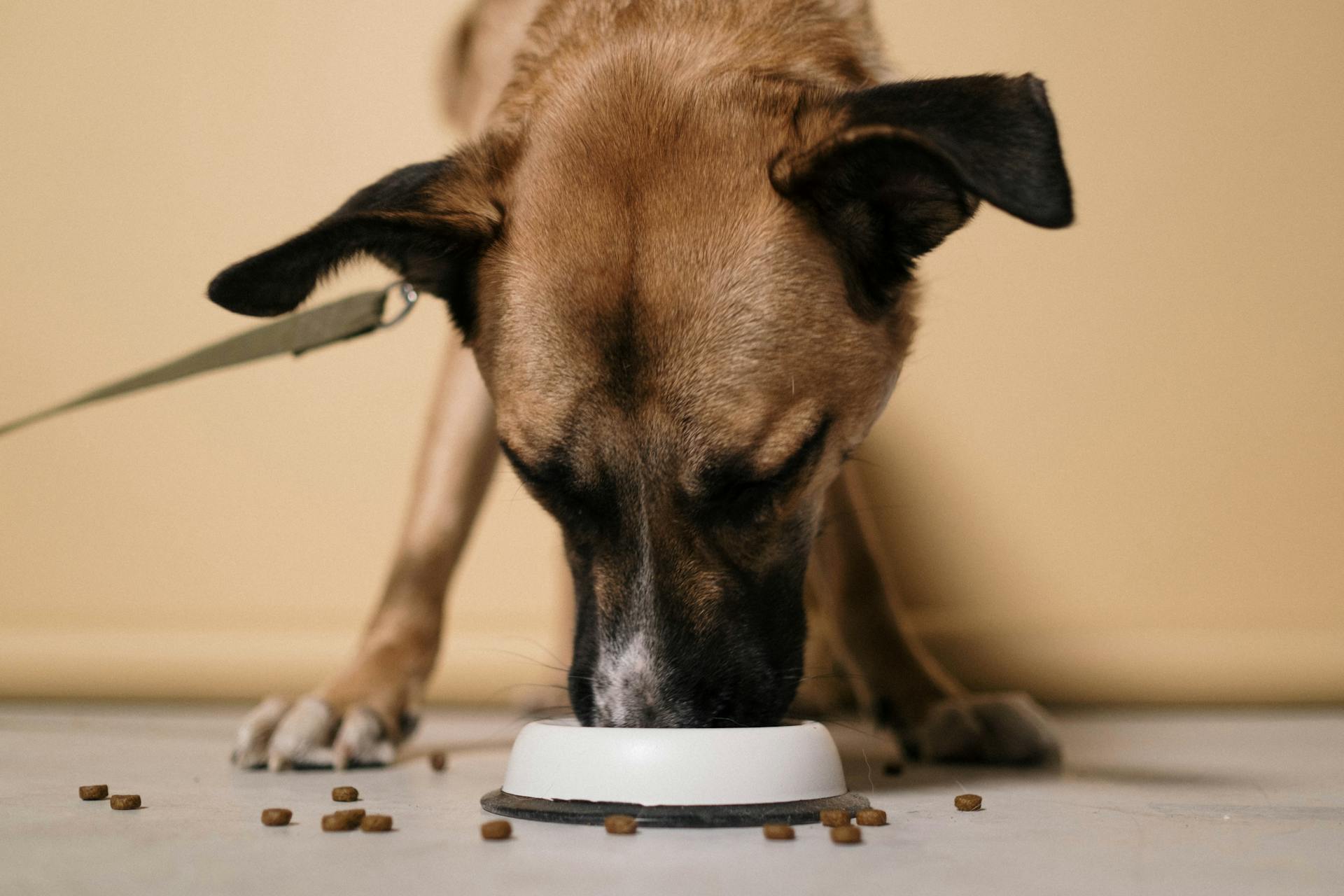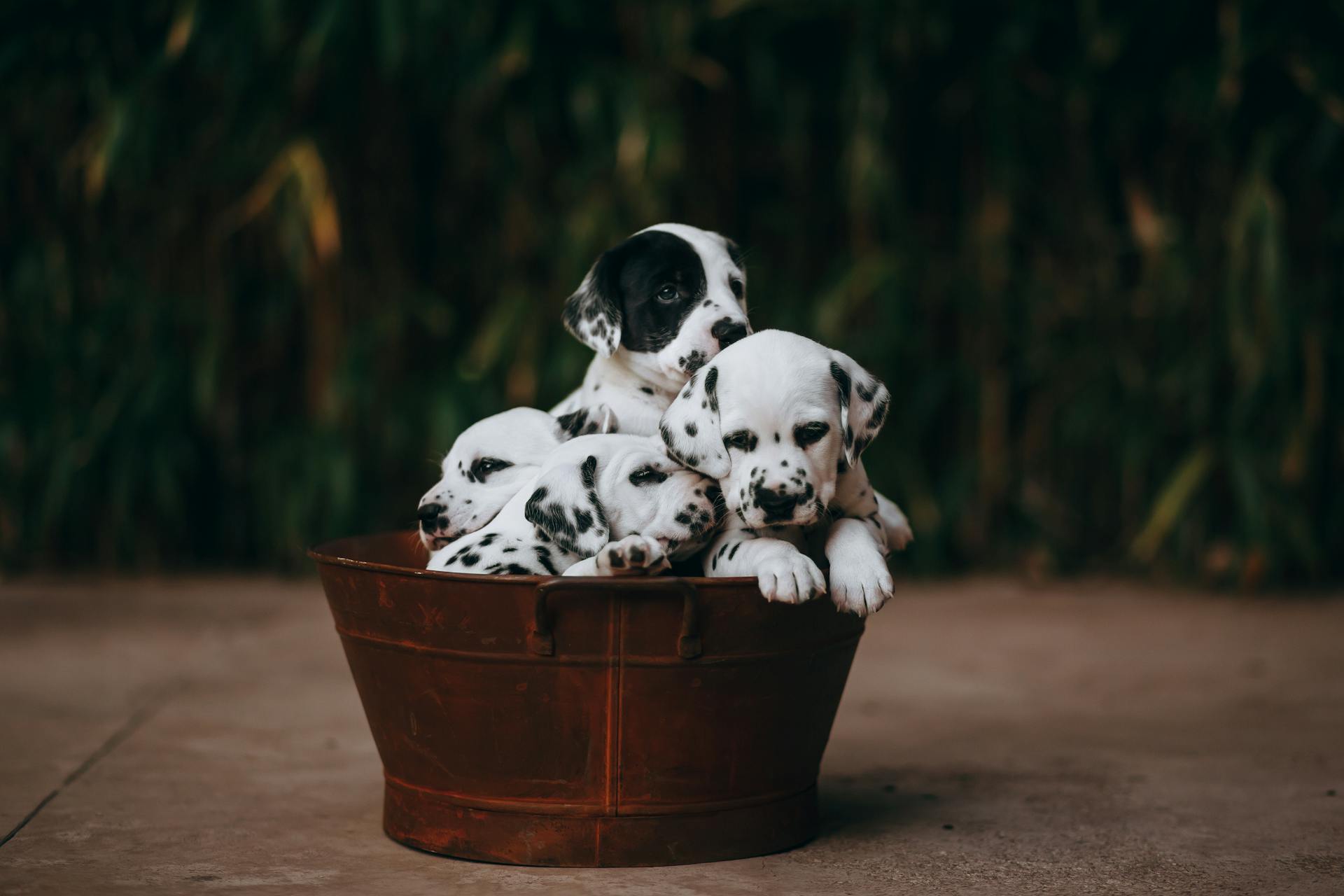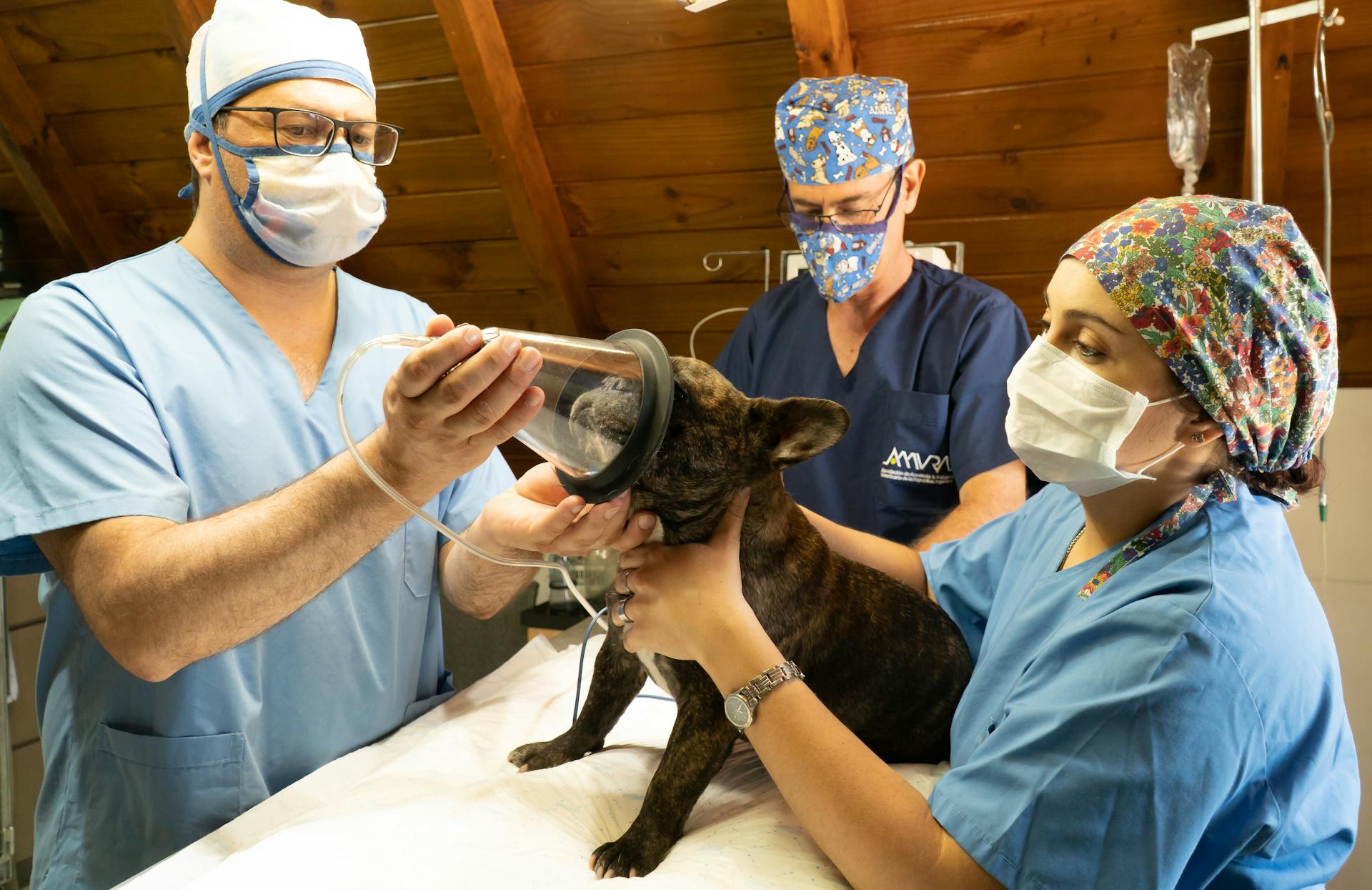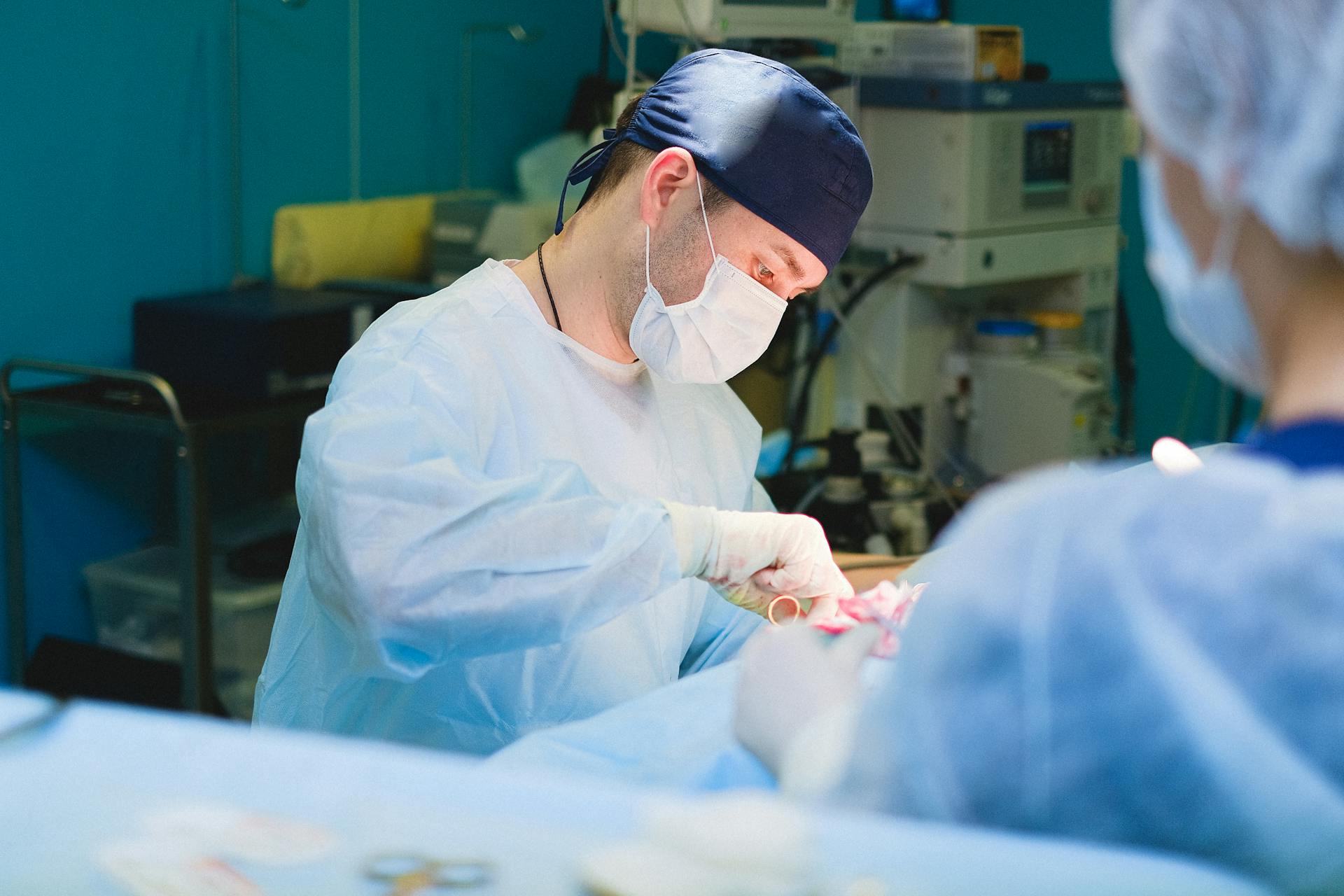
Dog bloat surgery can be a life-saving procedure, but it's essential to understand the survival rate and recovery process. A successful surgery can be achieved with a high success rate, but complications can still occur.
The average survival rate for dogs undergoing bloat surgery is around 70-80%, with some studies showing a higher success rate of up to 90%. This percentage can vary depending on the severity of the condition and the overall health of the dog.
Recovery from dog bloat surgery can take several weeks to a few months, with some dogs taking up to 6 months to fully recover. During this time, owners must closely monitor their dog's behavior, appetite, and overall health.
A key factor in a successful recovery is providing a quiet, stress-free environment for the dog, allowing them to rest and recover without any strenuous activities.
A different take: Dog Lump Removal Surgery Recovery
What is Dog Bloat?
Dog bloat, also known as gastric dilatation-volvulus (GDV), is a life-threatening condition that occurs when a dog's stomach fills with gas and twists, cutting off blood flow.
The stomach can twist in as little as 30 seconds, causing the dog to go into shock.
Dogs with deep chests, like Great Danes and German Shepherds, are more prone to bloat.
Gastric dilatation-volvulus can occur in any breed, but larger dogs are at higher risk.
A dog with bloat may exhibit symptoms such as restlessness, panting, and a distended abdomen.
If left untreated, bloat can lead to organ failure and death within 2-4 hours.
Bloat is often associated with eating habits, such as gobbling food quickly or eating too much at one time.
Explore further: Dogs Eating Hot Dogs
Symptoms and Diagnosis
Symptoms of dog bloat can develop quickly and get rapidly worse, so it's essential to recognize the signs. Retching or unproductive vomiting, bloat, restlessness, excessive drooling, collapse, difficulty breathing, and pale gums are all symptoms to watch out for.
If your dog is experiencing these symptoms, contact your vet immediately. The faster they receive treatment, the better their chance of survival.
Diagnosing bloat in dogs is usually straightforward, thanks to a combination of history, clinical signs, and abdominal x-rays. Bloodwork is also typically performed to assess dehydration, glucose levels, and kidney and liver function.
A different take: Signs Your Dog Doesn't Have Bloat
Diagnosing in Dogs
Diagnosing bloat in dogs is often a straightforward process. A veterinarian will typically take a dog's history, observe clinical signs, and perform an abdominal x-ray to diagnose bloat. Bloodwork is also usually performed to assess dehydration, glucose levels, and kidney and liver function.
The imaging test allows doctors to examine the distended stomach and check for a "double bubble", which is a sign of a twist in the stomach, also known as volvulus. This is a critical sign to look out for, as it indicates a more severe condition.
A veterinarian may also use bloodwork to assess a dog's overall health and determine the severity of the bloat. This can help identify any underlying issues that may have contributed to the bloat.
In some cases, a veterinarian may suspect bloat without seeing a "double bubble" on the x-ray. This is because bloat can occur without twisting, and this condition is still life-threatening.
Signs and Symptoms
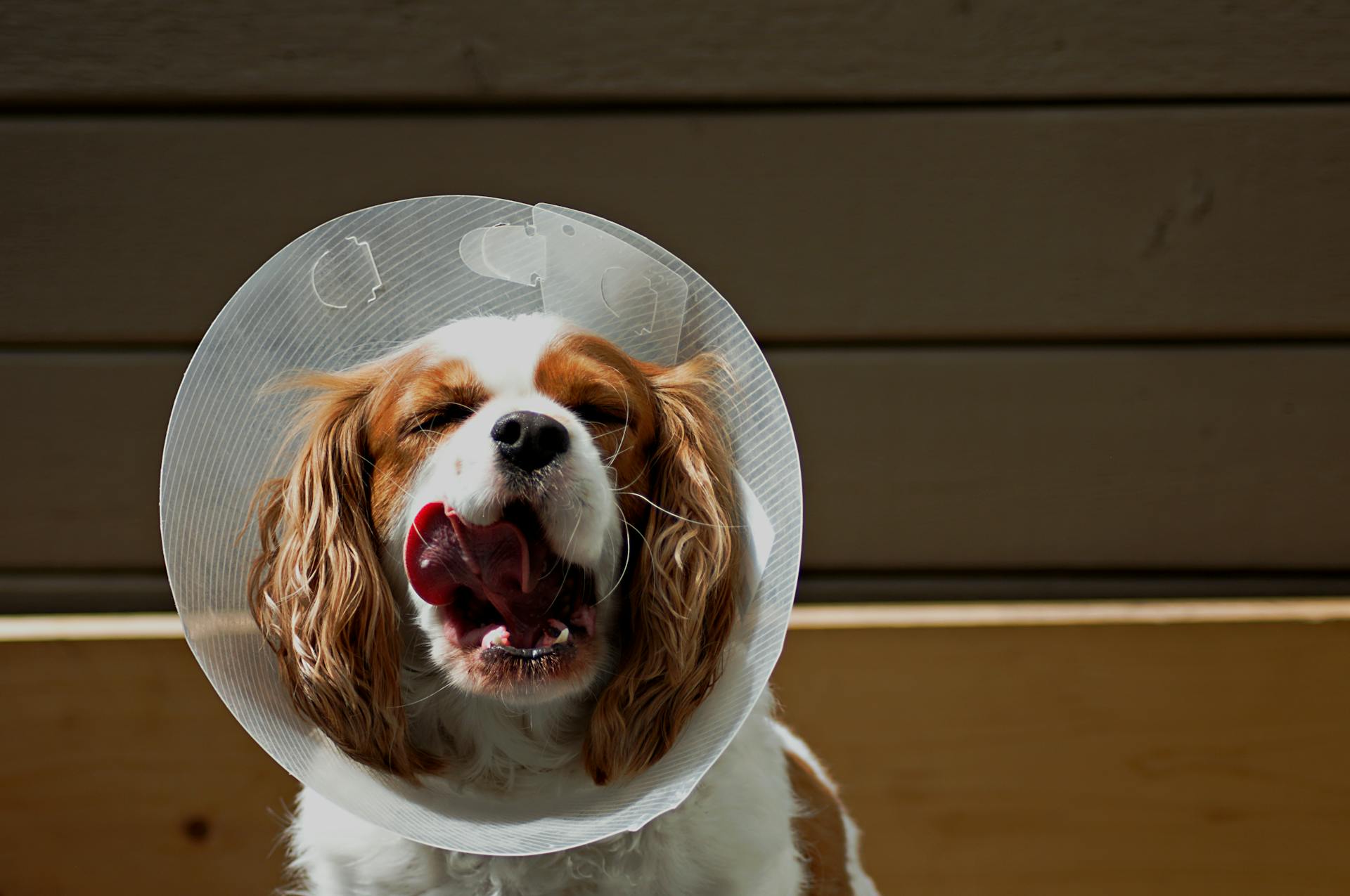
If your dog is developing symptoms of bloat, it's crucial to act fast. Symptoms often develop quickly, and get rapidly worse.
Contact your vet immediately if you notice any of the following signs. These can include a swollen stomach, drooling, pacing, agitation or restlessness, unsuccessful attempts to vomit, or pain.
As the condition progresses, you may notice your dog's gums turning pale, their pulse becoming rapid and weak, their heartbeat irregular, or their breathing becoming shallower. If you're unsure of the symptoms you're seeing, err on the side of caution and bring your dog to the vet or nearest animal hospital as soon as you can.
Here are some common signs of bloat to watch out for:
- Swollen stomach
- Drooling
- Pacing
- Agitation / restlessness
- Unsuccessful attempts to vomit (which may look like gagging or retching)
- Pain (indicators: panting, guarding of the stomach, pained facial expressions)
- Pale gums
- Rapid, weak pulse
- Irregular heartbeat
- Shortness of breath
- Weakness or collapse
When to Contact Your Vet
If your dog is showing any symptoms of GDV, contact your vet immediately. This is crucial because GDV is a life-threatening condition that requires prompt treatment.
Time is of the essence when dealing with GDV, so it's essential to know your nearest veterinary emergency facility in case your regular vet is not available after hours.
On a similar theme: Vet Dogs Dog Treats
You know your dog best, so trust your instincts and contact your vet if you're concerned about your dog's symptoms.
If your dog displays any signs of GDV, such as vomiting, restlessness, or abdominal pain, seek immediate veterinary advice.
GDV is a condition that can progress rapidly, so don't wait to see if your dog's symptoms resolve on their own.
Here are some common signs of GDV to watch out for:
Contact your vet if you notice any of these symptoms in your dog.
Treatment and Care
Seek immediate veterinary advice if your dog displays any signs of GDV, as without medical attention, almost all dogs that develop bloat will die.
Time is of the essence when dealing with cases of bloat, and the sooner your pet receives veterinary care, the better chance of a full recovery. This is why it's essential to have your nearest veterinary emergency facility on speed dial.
The severity of the case determines the treatment recommendation for the affected dog. At-risk breeds, such as giant breeds, should be familiar with their nearest veterinary emergency facility and have a plan in place in case of an emergency.
Broaden your view: Dog Breeds Watch Dogs
If your dog has a GDV, they will need rapid treatment from your vet, which is likely to include reducing bloat, treatment for shock, and surgery to untwist the stomach.
To increase the dog's chance of survival, treatment for GDV should be sought out as soon as possible. The success rate of preventing the recurrence of a GDV is 95% with a gastropexy.
In some cases, euthanasia may be the kindest option if your dog is very unwell, elderly, unlikely to survive the surgery, or surgery isn’t possible for another reason.
Here's a summary of the treatment process:
- Reduce bloat
- Treatment for shock
- Surgery to untwist the stomach
- Gastropexy to prevent recurrence
- Euthanasia in severe cases
Without surgery, a dog may bloat again at any time, even within hours. Studies have shown that 76% of dogs that have had an episode of GDV but do not undergo gastropexy will bloat again, with more than half bloating within three months.
Complications associated with gastropexy include heart arrhythmia, blood infection, severe inflammation of the abdominal lining, and a serious clotting disorder called “disseminated intravascular coagulation”.
Prognosis and Recovery
Dogs with GDV who don't receive treatment won't survive. However, up to 80% of dogs that receive prompt treatment of the condition do survive.
The risk for complications increases as disease severity and time increase. This means that if your dog shows clinical signs for more than 6 hours, it can lead to poor outcomes.
Dogs with certain risk factors may also require intensive care after surgery, including the possible need for blood transfusions and other specialized care. These risk factors include cardiac arrhythmias prior to surgery, requiring removal of a portion of the stomach due to loss of blood supply, and requiring removal of the spleen.
Recovery time for dogs that undergo gastropexy can be lengthy, with a hospital stay of at least a week, possibly longer, depending on the severity of the bloat.
Take a look at this: Dog Lump Removal Surgery Cost
Prognosis
If your dog is diagnosed with GDV, it's essential to know the prognosis. Dogs who receive prompt treatment have a good chance of survival, with up to 80% surviving.
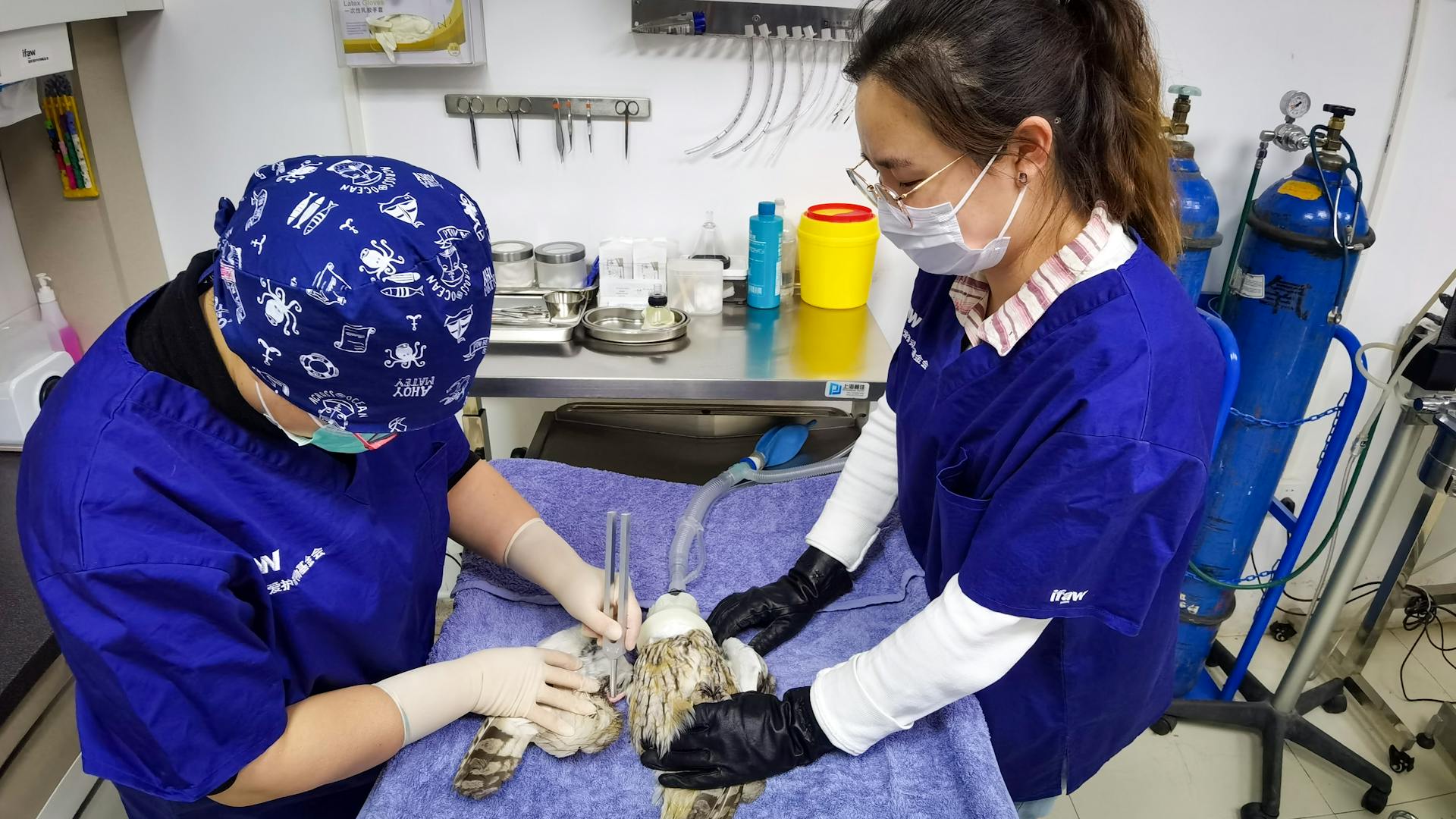
However, the risk of complications increases if your dog's condition worsens over time. This is especially true if your dog experiences clinical signs for more than 6 hours before receiving treatment.
If your dog has any of the following risk factors, the prognosis may be poorer: having cardiac arrhythmias prior to surgery, requiring removal of a portion of the stomach due to loss of blood supply, or requiring removal of the spleen.
In severe cases, dogs may require intensive care after surgery, including possible blood transfusions and other specialized care. This can be a challenging and stressful experience for both you and your dog.
Recovery and Management
Recovery time for dogs that undergo surgery for bloat can be lengthy, with hospital stays of at least a week, possibly longer, depending on the severity of the bloat.
A key aspect of post-op care is a special diet, which may include feeding your dog multiple small meals throughout the day instead of fewer large meals.
Medication will also be prescribed to aid in the recovery process.
A wound-management regimen will be necessary to ensure proper healing.
Limiting excessive water consumption after exercising is crucial to prevent stomach distension.
This means avoiding giving your dog too much water after physical activity, especially after meals.
Broaden your view: Can Dogs Get Bloat from Water
Emergency and Cost
Treatment for dog bloat can become very expensive, so it's essential to speak openly with your vet about the cost of treatment and what you think is right for your dog.
Dog owners should consider taking out dog insurance as soon as they bring their dog home, before any signs of illness start, to have some financial support in case their dog becomes unwell.
Emergency animal hospital visits are usually more expensive than a regular veterinary clinic.
Diagnostic tests, including X-rays, radiographs, blood work, and urine analysis, can add to the overall cost of treatment.
Surgery can cost anywhere between $1500 and $6000 or more, depending on the complexity of the bloat and where the surgery is performed.
A postoperative hospital stay and follow-up treatment will add to the bill as well.
The cost of treating dog bloat can reach the thousands, making it a significant financial burden for many dog owners.
Here are some estimated costs associated with treating dog bloat:
- Office visit: $500-$1000
- Diagnostic tests: $500-$1000
- Surgery: $1500-$6000 or more
- Postoperative hospital stay and follow-up treatment: $500-$1000
Veterinary costs will vary depending on your geographic location, with cities typically being more expensive than rural areas.
Frequently Asked Questions
Is GDV surgery worth it?
GDV surgery can significantly reduce the risk of death from gastric dilatation-volvulus, particularly in high-risk breeds. For Great Danes, a prophylactic gastropexy can lower the risk by nearly 30 times.
Can dogs survive bloat without surgery?
Without veterinary intervention, bloat can be fatal in a matter of hours. Prompt veterinary care and surgery are often the only ways to save a dog's life in cases of bloat.
What is the average cost of bloat surgery for dogs?
The average cost of bloat surgery for dogs is between $1,500 to $7,500, including post-operative care. This estimate may vary depending on the severity of the condition and the location of the veterinary clinic.
How long can a dog live with a twisted stomach?
Without treatment, a dog with a twisted stomach can die within an hour. Early treatment is crucial to prevent fatal outcomes.
What is the success rate of stomach flip surgery in dogs?
Early treatment of GDV (bloat) can be lifesaving, with a 90-95% survival rate for dogs undergoing surgery. However, if stomach tissue is dead, the survival rate drops to 50%
Sources
- https://www.akc.org/expert-advice/health/bloat-in-dogs/
- https://vmccny.com/gastric-dilatationvolvulus-bloat/
- https://www.pdsa.org.uk/pet-help-and-advice/pet-health-hub/conditions/gdv-gastric-dilatation-volvulus-in-dogs
- https://www.smalldoorvet.com/learning-center/medical/bloat-in-dogs/
- https://www.ethosvet.com/blog-post/german-shepherds-and-gastric-dilatation-volvulus-gdv-or-bloat/
Featured Images: pexels.com
